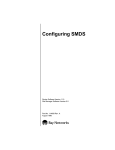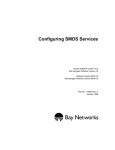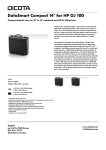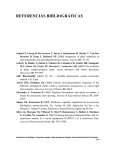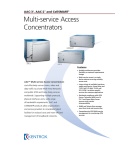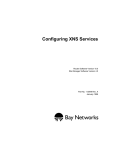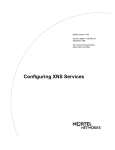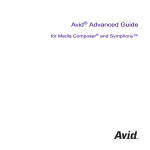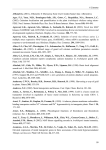Download Avaya Configuring SMDS User's Manual
Transcript
Configuring SMDS BayRS Version 12.00 Site Manager Software Version 6.00 Part No. 117361-A Rev. A September 1997 4401 Great America Parkway Santa Clara, CA 95054 8 Federal Street Billerica, MA 01821 Copyright © 1997 Bay Networks, Inc. All rights reserved. Printed in the USA. September 1997. The information in this document is subject to change without notice. The statements, configurations, technical data, and recommendations in this document are believed to be accurate and reliable, but are presented without express or implied warranty. Users must take full responsibility for their applications of any products specified in this document. The information in this document is proprietary to Bay Networks, Inc. The software described in this document is furnished under a license agreement and may only be used in accordance with the terms of that license. A summary of the Software License is included in this document. Trademarks ACE, AFN, AN, BCN, BLN, BN, BNX, CN, FN, FRE, GAME, LN, Optivity, PPX, Bay Networks, SynOptics, SynOptics Communications, Wellfleet and the Wellfleet logo are registered trademarks and Advanced Remote Node, ANH, ARN, ASN, Bay•SIS, BayStack, BayStream, BCNX, BLNX, EZ Install, EZ Internetwork, EZ LAN, IP AutoLearn, PathMan, PhonePlus, Quick2Config, RouterMan, SN, SPEX, Switch Node, Bay Networks Press, the Bay Networks logo and the SynOptics logo are trademarks of Bay Networks, Inc. All other trademarks and registered trademarks are the property of their respective owners. Restricted Rights Legend Use, duplication, or disclosure by the United States Government is subject to restrictions as set forth in subparagraph (c)(1)(ii) of the Rights in Technical Data and Computer Software clause at DFARS 252.227-7013. Notwithstanding any other license agreement that may pertain to, or accompany the delivery of, this computer software, the rights of the United States Government regarding its use, reproduction, and disclosure are as set forth in the Commercial Computer Software-Restricted Rights clause at FAR 52.227-19. Statement of Conditions In the interest of improving internal design, operational function, and/or reliability, Bay Networks, Inc. reserves the right to make changes to the products described in this document without notice. Bay Networks, Inc. does not assume any liability that may occur due to the use or application of the product(s) or circuit layout(s) described herein. Portions of the code in this software product are Copyright © 1988, Regents of the University of California. All rights reserved. Redistribution and use in source and binary forms of such portions are permitted, provided that the above copyright notice and this paragraph are duplicated in all such forms and that any documentation, advertising materials, and other materials related to such distribution and use acknowledge that such portions of the software were developed by the University of California, Berkeley. The name of the University may not be used to endorse or promote products derived from such portions of the software without specific prior written permission. SUCH PORTIONS OF THE SOFTWARE ARE PROVIDED “AS IS” AND WITHOUT ANY EXPRESS OR IMPLIED WARRANTIES, INCLUDING, WITHOUT LIMITATION, THE IMPLIED WARRANTIES OF MERCHANTABILITY AND FITNESS FOR A PARTICULAR PURPOSE. In addition, the program and information contained herein are licensed only pursuant to a license agreement that contains restrictions on use and disclosure (that may incorporate by reference certain limitations and notices imposed by third parties). ii 117361-A Rev. A Bay Networks, Inc. Software License Agreement NOTICE: Please carefully read this license agreement before copying or using the accompanying software or installing the hardware unit with pre-enabled software (each of which is referred to as “Software” in this Agreement). BY COPYING OR USING THE SOFTWARE, YOU ACCEPT ALL OF THE TERMS AND CONDITIONS OF THIS LICENSE AGREEMENT. THE TERMS EXPRESSED IN THIS AGREEMENT ARE THE ONLY TERMS UNDER WHICH BAY NETWORKS WILL PERMIT YOU TO USE THE SOFTWARE. If you do not accept these terms and conditions, return the product, unused and in the original shipping container, within 30 days of purchase to obtain a credit for the full purchase price 1. License Grant. Bay Networks, Inc. (“Bay Networks”) grants the end user of the Software (“Licensee”) a personal, nonexclusive, nontransferable license: a) to use the Software either on a single computer or, if applicable, on a single authorized device identified by host ID, for which it was originally acquired; b) to copy the Software solely for backup purposes in support of authorized use of the Software; and c) to use and copy the associated user manual solely in support of authorized use of the Software by Licensee. This license applies to the Software only and does not extend to Bay Networks Agent software or other Bay Networks software products. Bay Networks Agent software or other Bay Networks software products are licensed for use under the terms of the applicable Bay Networks, Inc. Software License Agreement that accompanies such software and upon payment by the end user of the applicable license fees for such software. 2. Restrictions on use; reservation of rights. The Software and user manuals are protected under copyright laws. Bay Networks and/or its licensors retain all title and ownership in both the Software and user manuals, including any revisions made by Bay Networks or its licensors. The copyright notice must be reproduced and included with any copy of any portion of the Software or user manuals. Licensee may not modify, translate, decompile, disassemble, use for any competitive analysis, reverse engineer, distribute, or create derivative works from the Software or user manuals or any copy, in whole or in part. Except as expressly provided in this Agreement, Licensee may not copy or transfer the Software or user manuals, in whole or in part. The Software and user manuals embody Bay Networks’ and its licensors’ confidential and proprietary intellectual property. Licensee shall not sublicense, assign, or otherwise disclose to any third party the Software, or any information about the operation, design, performance, or implementation of the Software and user manuals that is confidential to Bay Networks and its licensors; however, Licensee may grant permission to its consultants, subcontractors, and agents to use the Software at Licensee’s facility, provided they have agreed to use the Software only in accordance with the terms of this license. 3. Limited warranty. Bay Networks warrants each item of Software, as delivered by Bay Networks and properly installed and operated on Bay Networks hardware or other equipment it is originally licensed for, to function substantially as described in its accompanying user manual during its warranty period, which begins on the date Software is first shipped to Licensee. If any item of Software fails to so function during its warranty period, as the sole remedy Bay Networks will at its discretion provide a suitable fix, patch, or workaround for the problem that may be included in a future Software release. Bay Networks further warrants to Licensee that the media on which the Software is provided will be free from defects in materials and workmanship under normal use for a period of 90 days from the date Software is first shipped to Licensee. Bay Networks will replace defective media at no charge if it is returned to Bay Networks during the warranty period along with proof of the date of shipment. This warranty does not apply if the media has been damaged as a result of accident, misuse, or abuse. The Licensee assumes all responsibility for selection of the Software to achieve Licensee’s intended results and for the installation, use, and results obtained from the Software. Bay Networks does not warrant a) that the functions contained in the software will meet the Licensee’s requirements, b) that the Software will operate in the hardware or software combinations that the Licensee may select, c) that the operation of the Software will be uninterrupted or error free, or d) that all defects in the operation of the Software will be corrected. Bay Networks is not obligated to remedy any Software defect that cannot be reproduced with the latest Software release. These warranties do not apply to the Software if it has been (i) altered, except by Bay Networks or in accordance with its instructions; (ii) used in conjunction with another vendor’s product, resulting in the defect; or (iii) damaged by improper environment, abuse, misuse, accident, or negligence. THE FOREGOING WARRANTIES AND LIMITATIONS ARE EXCLUSIVE REMEDIES AND ARE IN LIEU OF ALL OTHER WARRANTIES EXPRESS OR IMPLIED, INCLUDING WITHOUT LIMITATION ANY WARRANTY OF MERCHANTABILITY OR FITNESS FOR A PARTICULAR PURPOSE. Licensee is responsible for the security of 117361-A Rev. A iii its own data and information and for maintaining adequate procedures apart from the Software to reconstruct lost or altered files, data, or programs. 4. Limitation of liability. IN NO EVENT WILL BAY NETWORKS OR ITS LICENSORS BE LIABLE FOR ANY COST OF SUBSTITUTE PROCUREMENT; SPECIAL, INDIRECT, INCIDENTAL, OR CONSEQUENTIAL DAMAGES; OR ANY DAMAGES RESULTING FROM INACCURATE OR LOST DATA OR LOSS OF USE OR PROFITS ARISING OUT OF OR IN CONNECTION WITH THE PERFORMANCE OF THE SOFTWARE, EVEN IF BAY NETWORKS HAS BEEN ADVISED OF THE POSSIBILITY OF SUCH DAMAGES. IN NO EVENT SHALL THE LIABILITY OF BAY NETWORKS RELATING TO THE SOFTWARE OR THIS AGREEMENT EXCEED THE PRICE PAID TO BAY NETWORKS FOR THE SOFTWARE LICENSE. 5. Government Licensees. This provision applies to all Software and documentation acquired directly or indirectly by or on behalf of the United States Government. The Software and documentation are commercial products, licensed on the open market at market prices, and were developed entirely at private expense and without the use of any U.S. Government funds. The license to the U.S. Government is granted only with restricted rights, and use, duplication, or disclosure by the U.S. Government is subject to the restrictions set forth in subparagraph (c)(1) of the Commercial Computer Software––Restricted Rights clause of FAR 52.227-19 and the limitations set out in this license for civilian agencies, and subparagraph (c)(1)(ii) of the Rights in Technical Data and Computer Software clause of DFARS 252.227-7013, for agencies of the Department of Defense or their successors, whichever is applicable. 6. Use of Software in the European Community. This provision applies to all Software acquired for use within the European Community. If Licensee uses the Software within a country in the European Community, the Software Directive enacted by the Council of European Communities Directive dated 14 May, 1991, will apply to the examination of the Software to facilitate interoperability. Licensee agrees to notify Bay Networks of any such intended examination of the Software and may procure support and assistance from Bay Networks. 7. Term and termination. This license is effective until terminated; however, all of the restrictions with respect to Bay Networks’ copyright in the Software and user manuals will cease being effective at the date of expiration of the Bay Networks copyright; those restrictions relating to use and disclosure of Bay Networks’ confidential information shall continue in effect. Licensee may terminate this license at any time. The license will automatically terminate if Licensee fails to comply with any of the terms and conditions of the license. Upon termination for any reason, Licensee will immediately destroy or return to Bay Networks the Software, user manuals, and all copies. Bay Networks is not liable to Licensee for damages in any form solely by reason of the termination of this license. 8. Export and Re-export. Licensee agrees not to export, directly or indirectly, the Software or related technical data or information without first obtaining any required export licenses or other governmental approvals. Without limiting the foregoing, Licensee, on behalf of itself and its subsidiaries and affiliates, agrees that it will not, without first obtaining all export licenses and approvals required by the U.S. Government: (i) export, re-export, transfer, or divert any such Software or technical data, or any direct product thereof, to any country to which such exports or re-exports are restricted or embargoed under United States export control laws and regulations, or to any national or resident of such restricted or embargoed countries; or (ii) provide the Software or related technical data or information to any military end user or for any military end use, including the design, development, or production of any chemical, nuclear, or biological weapons. 9. General. If any provision of this Agreement is held to be invalid or unenforceable by a court of competent jurisdiction, the remainder of the provisions of this Agreement shall remain in full force and effect. This Agreement will be governed by the laws of the state of California. Should you have any questions concerning this Agreement, contact Bay Networks, Inc., 4401 Great America Parkway, P.O. Box 58185, Santa Clara, California 95054-8185. LICENSEE ACKNOWLEDGES THAT LICENSEE HAS READ THIS AGREEMENT, UNDERSTANDS IT, AND AGREES TO BE BOUND BY ITS TERMS AND CONDITIONS. LICENSEE FURTHER AGREES THAT THIS AGREEMENT IS THE ENTIRE AND EXCLUSIVE AGREEMENT BETWEEN BAY NETWORKS AND LICENSEE, WHICH SUPERSEDES ALL PRIOR ORAL AND WRITTEN AGREEMENTS AND COMMUNICATIONS BETWEEN THE PARTIES PERTAINING TO THE SUBJECT MATTER OF THIS AGREEMENT. NO DIFFERENT OR ADDITIONAL TERMS WILL BE ENFORCEABLE AGAINST BAY NETWORKS UNLESS BAY NETWORKS GIVES ITS EXPRESS WRITTEN CONSENT, INCLUDING AN EXPRESS WAIVER OF THE TERMS OF THIS AGREEMENT. iv 117361-A Rev. A Contents About This Guide Before You Begin .............................................................................................................. xi Conventions ...................................................................................................................... xi Acronyms ..........................................................................................................................xii Ordering Bay Networks Publications ...............................................................................xiii Bay Networks Customer Service .....................................................................................xiv How to Get Help ..............................................................................................................xiv Chapter 1 SMDS Overview How SMDS Sends LAN Data over WANs .......................................................................1-2 SMDS Interface Protocol ................................................................................................1-2 Data Exchange Interface Protocol ..................................................................................1-4 PDU Assembly .........................................................................................................1-4 SMDS Individual Addresses ...........................................................................................1-7 SMDS Group Addresses ................................................................................................1-7 For More Information about SMDS .................................................................................1-7 Chapter 2 Implementation Notes Requirements for the Router and the DSU/CSU ............................................................2-3 DXI Protocol Requirements ......................................................................................2-3 Local Management Interface ....................................................................................2-3 Protocols Supported by SMDS .......................................................................................2-4 Priority of Heartbeat Poll Messages ...............................................................................2-4 Multinet ...........................................................................................................................2-5 Multigroup .......................................................................................................................2-7 Configuring Synchronous Lines for SMDS ...................................................................2-10 117361-A Rev. A v Chapter 3 Enabling SMDS Using the MIB Object ID .................................................................................................3-1 Enabling SMDS on an Interface .....................................................................................3-2 Chapter 4 Editing SMDS Parameters Editing SMDS Interface Parameters ...............................................................................4-2 SMDS Interface Parameter Descriptions .................................................................4-3 Deleting SMDS from the Router .....................................................................................4-7 Appendix A SMDS Default Settings Index vi 117361-A Rev. A Figures Figure 1-1. Figure 1-2. Figure 1-3. Figure 1-4. Figure 1-5. Figure 2-1. Figure 2-2. SMDS Sample Network ...........................................................................1-1 SMDS Interface Protocol Stack ...............................................................1-3 SMDS Level-3 PDU .................................................................................1-3 DXI Protocol .............................................................................................1-4 DXI Packet Assembly ...............................................................................1-6 Access to SMDS Network via a Router and DSU/CSU ...........................2-1 Low-Speed Access to SMDS Network .....................................................2-2 Figure 2-3. Figure 2-4. Figure 2-5. Figure 2-6. Figure 2-7. Figure 3-1. Figure 4-1. Figure 4-2. Low-Speed Access to SMDS Network via a Low-Speed DSU ................2-2 SMDS and IP Addresses for a Multinet Configuration .............................2-5 Multinet Configuration ..............................................................................2-6 Multigrouping SMDS and IP Addresses ...................................................2-7 Multigroup Configuration ..........................................................................2-9 SMDS Configuration Window ...................................................................3-2 Configuration Manager Window ...............................................................4-1 SMDS Interface List Window ...................................................................4-2 117361-A Rev. A vii Tables Table 2-1. Table A-1. 117361-A Rev. A Synchronous Line Parameter Settings for SMDS ..................................2-10 SMDS Interface Parameters ................................................................... A-1 ix About This Guide If you are responsible for configuring and managing Bay Networks® routers or BayStream™ platforms, read this guide to learn how to customize Bay Networks software for Switched Multimegabit Data Service (SMDS). If you want to Go to Learn about the SMDS protocol Chapter 1 Read implementation notes that may affect how you configure SMDS Chapter 2 Enable SMDS on your router Chapter 3 Edit SMDS interface parameters and configure SMDS Chapter 4 Look up default settings for SMDS parameters Appendix A Before You Begin Before using this guide, you must complete the following procedures: • Create and save a configuration file that has at least one SMDS interface. • Retrieve the configuration file in local, remote, or dynamic mode. For instructions, refer to Configuring and Managing Routers with Site Manager. Conventions bold text Indicates text that you need to enter, command names, and buttons in menu paths. Example: Enter wfsm & Example: Use the dinfo command. 117361-A Rev. A xi Configuring SMDS Example: ATM DXI > Interfaces > PVCs identifies the PVCs button in the window that appears when you select the Interfaces option from the ATM DXI menu. italic text Indicates variable values in command syntax descriptions, new terms, file and directory names, and book titles. quotation marks (“ ”) Indicate the title of a chapter or section within a book. screen text Indicates data that appears on the screen. Example: Set Bay Networks Trap Monitor Filters separator ( > ) Separates menu and option names in instructions and internal pin-to-pin wire connections. Example: Protocols > AppleTalk identifies the AppleTalk option in the Protocols menu. Example: Pin 7 > 19 > 20 vertical line (|) Indicates that you enter only one of the parts of the command. The vertical line separates choices. Do not type the vertical line when entering the command. Example: If the command syntax is show at routes | nets, you enter either show at routes or show at nets, but not both. Acronyms xii ARP Address Resolution Protocol ATM Asynchronous Transfer Mode CRC Cyclic Redundancy Check DSU/CSU Digital Service Unit/Channel Service Unit DS1 Digital Service, Level 1 DS3 Digital Service, Level 3 DXI data exchange interface HSSI high-speed serial interface IEEE Institute of Electrical and Electronic Engineers IP Internet Protocol IPX Internet Packet Exchange 117361-A Rev. A About This Guide LAN local area network LMI Local Management Interface MAC media access control MAN metropolitan area network OSI Open Systems Interconnection OSPF Open Shortest Path First PDU protocol data unit PVCs permanent virtual circuits RIP Routing Information Protocol SIP SMDS Interface Protocol SMDS Switched Multimegabit Data Service SNI subscriber network interface SNMP Simple Network Management Protocol WAN wide area network XNS Xerox Network System Ordering Bay Networks Publications To purchase additional copies of this document or other Bay Networks publications, order by part number from Bay Networks Press™ at the following numbers: • Phone--U.S./Canada: 888-422-9773 • Phone--International: 510-490-4752 • FAX--U.S./Canada and International: 510-498-2609 The Bay Networks Press catalog is available on the World Wide Web at support.baynetworks.com/Library/GenMisc. Bay Networks publications are available on the World Wide Web at support.baynetworks.com/Library/tpubs. 117361-A Rev. A xiii Configuring SMDS Bay Networks Customer Service You can purchase a support contract from your Bay Networks distributor or authorized reseller, or directly from Bay Networks Services. For information about, or to purchase a Bay Networks service contract, either call your local Bay Networks field sales office or one of the following numbers: Region Telephone number Fax number United States and Canada 800-2LANWAN; then enter Express Routing Code (ERC) 290, when prompted, to purchase or renew a service contract 508-916-3514 508-916-8880 (direct) Europe 33-4-92-96-69-66 33-4-92-96-69-96 Asia/Pacific 61-2-9927-8888 61-2-9927-8899 Latin America 561-988-7661 561-988-7550 Information about customer service is also available on the World Wide Web at support.baynetworks.com. How to Get Help If you purchased a service contract for your Bay Networks product from a distributor or authorized reseller, contact the technical support staff for that distributor or reseller for assistance. If you purchased a Bay Networks service program, call one of the following Bay Networks Technical Solutions Centers: xiv Technical Solutions Center Telephone number Fax number Billerica, MA 800-2LANWAN 508-916-3514 Santa Clara, CA 800-2LANWAN 408-495-1188 Valbonne, France 33-4-92-96-69-68 33-4-92-96-69-98 Sydney, Australia 61-2-9927-8800 61-2-9927-8811 Tokyo, Japan 81-3-5402-0180 81-3-5402-0173 117361-A Rev. A Chapter 1 SMDS Overview Switched Multimegabit Data Service (SMDS) is a public, high-speed, packet-switched network service that enables you to connect local area networks (LANs) across wide area networks (WANs). SMDS technology combines cell relay technology and IEEE Standard 802.6, the link control protocol standard that controls cell transmission. To send information across the network, SMDS divides data into fixed 53-byte cells. The use of cell technology makes SMDS well suited for traffic that consumes high bandwidth for short periods of time. Figure 1-1 illustrates an SMDS network. In this illustration, LAN 1 communicates to LANs 2 and 3 through a router connected to an SMDS Digital Service Unit/Channel Service Unit (DSU/CSU). The DSU/CSU changes the frame-based data from the router into cells that can then be sent across the SMDS network. LAN 2 LAN 1 SMDS network T3 Router SMDS switch DSU/ CSU DSU/ CSU SMDS switch Router LAN 3 T3 T3 SNI SNI DSU/ CSU SMDS switch Router SNI SMS0001A Figure 1-1. 117361-A Rev. A SMDS Sample Network 1-1 Configuring SMDS The point at which the DSU/CSU meets the network is the subscriber network interface (SNI). This is the access point to the SMDS network. Within the switching system of the SMDS network, T3 communication lines connect the network switches together. Because data traffic and network equipment are different for each SMDS customer, SMDS defines several access classes. Access classes are speeds at which data travels from the customer site to the network switch. SMDS currently offers six network access classes: 1.2 Mb/s, 4 Mb/s, 10 Mb/s, 16 Mb/s, 25 Mb/s, and 34 Mb/s. The 1.2 Mb/s class is for T1 lines. Classes 4 Mb/s through 34 Mb/s are for T3 lines. SMDS also offers low-speed SMDS classes, which operate at fractional T1/E1 speeds (56 Kb/s up to 64 Kb/s). How SMDS Sends LAN Data over WANs LAN data is typically connectionless data. This means that it has addressing information in each frame, so there is no need for a prior connection between the origination and destination devices. WAN data is typically connection-oriented data. This means that it needs a virtual circuit -- that is, a predefined path across physical lines -- between the two connection points prior to sending data. SMDS provides connectionless data transfer across a wide area network without establishing a logical end-to-end connection. SMDS Interface Protocol The SMDS Interface Protocol (SIP) defines SMDS addressing, formatting, framing, and error-detection requirements. The SIP has three levels that are similar to, but do not match, the protocol layers that make up the OSI protocol model. • Level 3 specifies the addressing, formatting, and encapsulation of packet data, referred to as Level-3 PDUs. • Level 2 specifies the segmentation of Level-3 Protocol Data Units (PDUs) into short, fixed-length SMDS cells, referred to as Level-2 PDUs. • Level 1 specifies the physical connectivity that enables transmission. Figure 1-2 illustrates the SIP protocol stack. 1-2 117361-A Rev. A SMDS Overview Level 1 Encapsulates data into PDUs Level 2 Segments data into 53-byte PDUs Level 3 Prepares Level-2 PDUs for the physical medium SMS0002A Figure 1-2. SMDS Interface Protocol Stack SIP specifies that the SMDS source and destination addresses reside in the Level-3 PDU header (Figure 1-3). Each header contains a MAC-level address in an E.164 address format. E.164 formats are 64 bits long and provide both individual and multicast addresses. Network switches use the address information in the header to route the PDU to its destination. Trailer Header LAN packet SMS0003A Figure 1-3. SMDS Level-3 PDU One or more SMDS devices, for example DSUs and routers, can perform the tasks of the three SIP levels, as described in the next section. 117361-A Rev. A 1-3 Configuring SMDS Data Exchange Interface Protocol For SMDS high-speed access classes, that is, speeds from 1.2 Mb/s to 34 Mb/s, the SMDS Interest Group (SIG) wanted to simplify the integration of SMDS into existing network equipment, and to hasten SMDS into the market. To do this, they divided the functions defined by the SIP levels between devices that handle local network packets (for example, a router) and devices that interface with the digital services provided by common carriers (a DSU/CSU). The Data Exchange Interface (DXI) protocol defines this division of tasks and describes the router and DSU/CSU relationship (Figure 1-4). Refer to the next section for more information. SMDS network Router DSU/CSU SMDS switch SMDS switch DSU/CSU Router DXI protocol defines the router and DSU/CSU interface SMS0005A Figure 1-4. DXI Protocol For low-speed SMDS (56 Kb/s to 64 Kb/s), the DXI is extended out to the SMDS network. In this case, you do not need a special SMDS DSU/CSU. PDU Assembly SMDS PDU assembly begins when the router receives a network-generated packet. The router takes the entire packet and encapsulates it within a 36-byte header (containing addressing, length, and control information) and a 4-byte trailer (containing a CRC value), thereby creating an SMDS Level-3 PDU (Figure 1-5). 1-4 117361-A Rev. A SMDS Overview The router next prepares the Level-3 PDU for transmission to the DSU/CSU by encapsulating it within a DXI header and trailer that provide control information. Upon receiving the DXI packet, the DSU/CSU strips the DXI header/trailer and divides the Level-3 PDU into fixed-length (44-byte) units called cells. The DSU/CSU encapsulates these cells within a 7-byte header and 2-byte trailer to form Level-2 PDUs. Finally, the DSU/CSU inserts an additional four bytes of framing information between each Level-2 PDU and transmits the framed cells across a Digital Service Level 1 (DS1) or DS3 connection to the SMDS network. Figure 1-5 shows the assembly of SMDS cells as specified by the DXI. 117361-A Rev. A 1-5 Configuring SMDS Switch receives LAN packet Level-3 encapsulation PAYLOAD PAYLOAD Switch 36-byte header 4-byte trailer PAYLOAD DXI header DXI trailer DXI PAYLOAD Level-2 segmentation DSU/CSU 4-byte trailer PAYLOAD PAYLOAD 7-byte 44-byte 2-byte trailer header cell 7-byte 44-byte 2-byte trailer header cell PAYLOAD PAYLOAD 7-byte 44-byte 2-byte trailer header cell PAYLOAD Framing field PAYLOAD Framing field SMDS network SMS0004A Figure 1-5. 1-6 DXI Packet Assembly 117361-A Rev. A SMDS Overview SMDS Individual Addresses An SMDS individual address is a unique address that the SMDS provider assigns to an SNI. Specifically, an individual address is a media access control layer (MAC) address in an E.164 format. An E.164 address is a 64-bit address, which for SMDS is similar to a phone number. For example, the phone number (617) 555-3923 becomes individual address C161 75 55 39 23 FF FF. The C indicates that the address is an individual address, and the 1 is a standard prefix. There can be up to 16 individual addresses for one SNI. SMDS Group Addresses An SMDS group address is one address that instructs an SMDS switch to broadcast information, such as routing information packets (RIP) and address resolution packets (ARP), from the router to multiple destination nodes. SMDS individual addresses within the SMDS group identify these nodes. Like an SMDS individual address, the group address is a media access control layer (MAC) address in an E.164 format. An E.164 address is a 64-bit address, which for SMDS is similar to a phone number. For example, the phone number (508) 555-1144 becomes individual address E1 50 85 55 11 44 FF FF. The E indicates that the address is a group address and the 1 is a standard prefix. For More Information about SMDS The following documents provide technical details on SMDS and DXI protocol design and implementation. Baker, F. and C Kolb. Definitions of Managed Objects for the DS1 Interface Type . RFC 1232. Network Information Center (NIC), SRI International, Menlo Park, California, May 1991. Bellcore. Generic Requirements for SMDS Customer Network Management Service. Technical Advisory TA-TSV-001062. Issue 2. February 1992. Bellcore. Generic System Requirements in Support of Switched Multi-Megabit Data Service. Technical Reference TR-TSV-000772. Issue 1. May 1991. 117361-A Rev. A 1-7 Configuring SMDS Bellcore. Local Access System Generic Requirements, Objectives, and Interfaces in Support of Switched Multi-Megabit Data Service. Technical Reference TR-TSV-000773. Issue 1. June 1991. Cox, T. and K. Tesink. Definitions of Managed Objects for the DS3 Interface Type. RFC 1233. Network Information Center (NIC), SRI International, Menlo Park, California, May 1991. Klessig, R. and K. Tesink. SMDS: Wide-Area Data Networking with Switched Multi-megabit Data Service. Englewood, New Jersey: Prentice Hall, Inc., 1995. Piscitello, D. and J. Lawrence. The Transmission of IP Datagrams over the SMDS Service. RFC 1209. Network Information Center (NIC), SRI International, Menlo Park, California, March 1991. SMDS Interest Group. SMDS Data Exchange Interface Protocol. Revision 3.2. Technical Specification SIG-TS-001/1991. October 1991. SMDS Interest Group. SMDS DXI Local Management Interface. Technical Specification SIG-TS-002/1992. May 1992. The following publications provide a less technical introduction to SMDS: Davidson, R. and N. Muller. The Guide to SONET: Planning, Installing & Maintaining Broadband Networks. Telecom Library, Inc., 1991. Goldstein, F. ISDN in Perspective. Reading, Mass.: Addison-Wesley, 1992. 1-8 117361-A Rev. A Chapter 2 Implementation Notes This chapter provides information about the Bay Networks implementation of SMDS. Specifically, it contains information about the router’s DXI protocol requirements and the Local Management Interface protocol. This chapter also supplies details on the use of SMDS group and individual addresses for multinet and multigroup configurations. To implement high-speed SMDS, you need a Bay Networks router and an SMDS DSU/CSU that provides DS1- or DS3-based access to the switched SMDS network. A synchronous or high-speed serial interface (HSSI) physically connects the router and the DSU/CSU (Figure 2-1). DSU/CSU Router SMDS network HSSI or synchronous interface SMS0006A Figure 2-1. Access to SMDS Network via a Router and DSU/CSU The router also supports low-speed SMDS through the SNI and DXI specifications standardized by the SMDS Interest Group. If you are running low-speed SMDS, you can extend the DXI to the SMDS network, thereby eliminating the need for a special SMDS DSU/CSU. Any synchronous interface, including MCT1 or MCE1 link modules, physically connects the router and the network (Figure 2-2). 117361-A Rev. A 2-1 Configuring SMDS SMDS network Router Synchronous or MCT1/MCE1 interface (Low speed only) SMS0011A Figure 2-2. Low-Speed Access to SMDS Network Another low-speed SMDS option is to use a low-speed DSU/CSU to connect to the network. In this case, a V.35 cable physically connects the router to the DSU/CSU (Figure 2-3). Low-speed DSU/CSU Router SMDS network V.35 interface SMS0012A Figure 2-3. 2-2 Low-Speed Access to SMDS Network via a Low-Speed DSU 117361-A Rev. A Implementation Notes Requirements for the Router and the DSU/CSU The next sections provide configuration requirements for the router and the DSU/CSU to implement high-speed SMDS. DXI Protocol Requirements Version 3.2 of the DXI protocol manages the data exchange between the router and the DSU/CSU. Because the router does not support earlier DXI versions, the DSU/CSU must support DXI Version 3.2. DXI Version 3.2 provides an optional heartbeat poll mechanism to periodically verify the router and DSU/CSU connection. Be sure to enable heartbeat polling on the DSU/CSU. The DXI also provides support for both 16-bit and 32-bit cyclic-redundancy checks (CRCs). Network devices use CRCs to check data for transmission errors. When the router or DSU/CSU receives data, each reads the CRC character and compares the value it calculates to the actual CRC character in the data packet. Ensure that the CRC values for the router and the DSU/CSU match. This means that if you set the router to 16-bit CRCs, you must set the DSU/CSU to 16-bit CRCs. If necessary, you can modify the CRC values (16-bit or 32-bit) for both synchronous and HSSI connections. Local Management Interface The Local Management Interface (LMI) protocol works with the DXI to enable the router and the DSU/CSU to exchange management information. The LMI uses a subset of the Simple Network Management Protocol (SNMP) to provide for router management queries, DSU/CSU responses to queries, and DSU/CSU-generated asynchronous trap events. Before enabling the LMI on the router, ensure that the DSU/CSU supports this protocol and that you enable it on the DSU/CSU. 117361-A Rev. A 2-3 Configuring SMDS Protocols Supported by SMDS SMDS can operate with the following protocols: • AppleTalk • APPN • Bridge (including Spanning Tree) • DECnet IV • DLSw • Internet Protocol (IP), including Address Resolution Protocol (ARP) support • Internet Packet Exchange (IPX) • LLC2 • Native Mode LAN • Source Routing with Bay Networks 8101 encapsulation • Source Routing with Spanning Tree • VINES • Xerox Network System (XNS) Note: SMDS does not support OSI. Priority of Heartbeat Poll Messages When you select SMDS on a circuit, the router automatically assigns the highest priority to heartbeat poll and LMI messages that it sends to the DSU/CSU. The heartbeat poll and LMI messages must have priority over other data to ensure that during heavy traffic conditions, the link stays up and allows these messages to get through to the DSU/CSU. 2-4 117361-A Rev. A Implementation Notes Multinet Multinet, a feature of the Internet Protocol (IP), allows you to support many IP networks over one SMDS line by allowing many hosts on a single logical IP subnetwork. A multinet network is economical because you do not have to purchase as many SMDS group addresses from your SMDS provider as you might with other configurations. Multinet configurations enable you to configure one SMDS individual address and one SMDS group address for a single SNI and then associate many logical IP subnetworks with these single SMDS addresses. A logical IP subnetwork is a host that is directly connected to the SMDS network. A second variation of a multinet configuration allows you to have multiple SMDS individual addresses along with a single SMDS group address by configuring an individual address per IP host address for the same group address. For information about IP, refer to Configuring IP Services. Figure 2-4 shows the two types of multinet configurations. Type 1 Single group and individual addresses, multiple IP addresses Group address Individual address lP address lP address lP address Type 2 Single group address, multiple individual and IP addresses Group address Individual address Individual address Individual address lP address lP address lP address SMS0010A Figure 2-4. SMDS and IP Addresses for a Multinet Configuration Figure 2-5 on page 2-6 shows a sample multinet configuration, where several IP networks are using one SNI. Each side of the network shows a different use of group and individual addresses for connecting to the IP networks. A multinet configuration allows for efficient network addressing and a cost-effective method of implementing SMDS. 117361-A Rev. A 2-5 Configuring SMDS Router Single group address for a single SNI IP address: 128.1.1.1 Addr. mask: 255.255.255.0 Individual address: C14089991000FFFF Group and ARP address: E18008881000FFFF SMDS network Individual address: C14089991001FFFF Group and ARP address: E18008881000FFFF Individual address: C14089991002FFFF Group and ARP address: E18008881000FFFF Single group addresses for a single SNI Router IP address: 128.1.1.4 Addr. mask: 255.255.255.0 IP address: 150.50.1.1 Addr. mask: 255.255.255.0 This side shows one group address with many individual and IP addresses Individual address: C14089991003FFFF Group and ARP address: E18008881000FFFF Router IP address: 128.1.1.2 Addr. mask: 255.255.255.0 IP address: 150.50.1.2 Addr. mask: 255.255.255.0 This side shows one group address with one individual address and many IP addresses Key Logical IP interface Physical SMDS line SMS0007A Figure 2-5. 2-6 Multinet Configuration 117361-A Rev. A Implementation Notes To configure multinet, follow these steps: 1. In your SMDS configuration parameters, enter addresses in the Group Address, ARP Address, and Individual Address parameters described in Chapter 3 of this book. 2. In your IP interface configuration, enter the same addresses that you entered in the SMDS parameters in the previous step. The equivalent IP parameters are SMDS Group Address, SMDS ARP Req Address, and MAC Address. Refer to Configuring IP Services for information about these IP parameters. 3. Add a new IP interface with a unique IP address, which includes a network/subnet and host address. 4. Enter the same Group Address, ARP Address, and Individual Address that you entered in Step 2 for this new IP interface. Note: You may also configure many individual addresses for an SMDS group address, but ensure that each individual address within a group is unique. Multigroup Multigroup is a feature of the Internet Protocol (IP) that enables you to configure multiple SMDS group addresses on the same SNI, which is the access interface to the SMDS network. The router implements multigroup according to RFC 1209. For information about IP, refer to Configuring IP Services. Figure 2-6 shows a multigroup configuration. Group address Group address Group address Individual address Individual address Individual address lP address lP address lP address SMS0009A Figure 2-6. Multigrouping SMDS and IP Addresses Once you configure an SMDS group address, you can then assign this group address to at least one IP subnetwork. An IP address identifies the subnetwork. 117361-A Rev. A 2-7 Configuring SMDS By associating or pairing a different SMDS group address with each IP address, you achieve multigrouping. A multigroup configuration enables you to use one SMDS physical line (SNI) to connect many nodes located on different subnetworks. It also allows you to limit broadcast and multicast traffic, such as Routing Information Protocol (RIP) updates, Address Resolution Protocol (ARP) updates, and Open Shortest Path First (OSPF) messages, to their respective SMDS groups. For example, in Figure 2-7, two separate subnetworks share the same SNI. The routers in these networks use RIP updates to communicate network information. The routers broadcast RIP updates to each node on the network. Because each RIP network shares an SNI, the only way to prevent RIP updates from interfering with one another is to isolate these subnetworks by associating each one with a different SMDS group address. 2-8 117361-A Rev. A Implementation Notes Router IP address: 128.1.1.1 Addr. mask: 255.255.255.0 Single group addresses for a single SNI Individual address: C14089991000FFFF Group and ARP address: E18008881000FFFF SMDS network Individual address: C14089991001FFFF Group and ARP address: E18008881000FFFF Individual address: C14089991003FFFF Group and ARP address: E18008881000FFFF Multiple group addresses for a single SNI Multiple group addresses for a single SNI Individual address: C14089991004FFFF Group and ARP address: E18008882000FFFF Individual address: C14089991002FFFF Group and ARP address: E18008882000FFFF Router IP address: 128.1.1.3 Addr. mask: 255.255.255.0 IP address: 150.50.1.2 Addr. mask: 255.255.255.0 Router IP address: 128.1.1.2 Addr. mask: 255.255.255.0 IP Address: 150.50.1.1 Addr. mask: 255.255.255.0 Key Logical IP interface Physical SMDS line SMS0008A Figure 2-7. 117361-A Rev. A Multigroup Configuration 2-9 Configuring SMDS To configure multigroup, follow these steps: 1. In your SMDS configuration parameters, enter addresses in the Group Address, ARP Address, and Individual Address parameters described in Chapter 3 of this book. 2. In your IP interface configuration, enter the same addresses that you entered in the SMDS parameters in the previous step. The equivalent IP parameters are SMDS Group Address, SMDS ARP Req Address, and MAC Address. Refer to Configuring IP Services for information about these IP parameters. 3. Add a new IP interface with a unique IP subnetwork address. This address should include a network/subnet and host address. 4. Enter a new Group Address, ARP Address, and Individual Address for this new IP interface. The IP interface parameters override these same parameters in the SMDS configuration for this and subsequent IP interfaces. Configuring Synchronous Lines for SMDS If you enable SMDS on a circuit, Site Manager automatically sets the following synchronous line parameters. Table 2-1. Synchronous Line Parameter Settings for SMDS Parameter Value BOFL Disable Promiscuous Enable Service Transparent WAN Protocol SMDS For more information about these parameters, refer to Configuring and Managing Routers with Site Manager. 2-10 117361-A Rev. A Chapter 3 Enabling SMDS This chapter provides information on how to enable SMDS. It assumes you have read Configuring and Managing Routers with Site Manager and that you have 1. Opened a configuration file 2. Specified router hardware, if this is a local mode configuration file 3. Selected the link or net module connector on which you are enabling SMDS When you enable SMDS, you need to configure only a few parameters. The Configuration Manager supplies default values for the remaining parameters. If you want to edit these default values, refer to Chapter 4 for instructions. Using the MIB Object ID For each parameter, this chapter and Chapter 4 include default settings, valid parameter options, the parameter function, instructions for setting the parameter, and the Management Information Base (MIB) object ID. The Technician Interface allows you to modify parameters by issuing set and commit commands with the MIB object ID. This process is equivalent to modifying parameters using Site Manager. For more information about using the Technician Interface to access the MIB, refer to Using Technician Interface Software. Caution: The Technician Interface does not verify that the value you enter for a parameter is valid. Entering an invalid value can corrupt your configuration. 117361-A Rev. A 3-1 Configuring SMDS Enabling SMDS on an Interface To enable SMDS on an interface, complete the following steps. 1. Select SMDS from the WAN Protocols menu; this menu appears after you select a link or net module connector that requires a WAN circuit. Site Manager automatically enables protocol prioritization when you select SMDS. For detailed information on protocol prioritization, refer to Configuring Traffic Filters and Protocol Prioritization. 2. Click on OK to enable default SMDS. The Configuration Manager displays the SMDS Configuration window (Figure 3-1). 3. Configure the SMDS parameters (Individual Address, Group Address, and ARP Address) using the descriptions that follow as a guide. 4. When you have configured all the parameters, you can do one of the following: • Enable default SMDS. To do this, click on OK. • Edit the default values. To do this, click on Details. (Refer to Chapter 4 for instructions.) Figure 3-1. 3-2 SMDS Configuration Window 117361-A Rev. A Enabling SMDS Parameter: Individual Address Default: C1FFFFFFFFFFFFFF Options: A complete SMDS E.164 address specified by the SMDS subscription agreement that you have with your SMDS provider Function: Instructions: Provides a MAC-layer address. Enter the complete SMDS E.164 address; for example, C15085558734FFFF. To configure this parameter for a multigroup or multinet configuration, refer to Chapter 2 for instructions. For information about IP, refer to Configuring IP Services. MIB Object ID: Parameter: 1.3.6.1.4.1.18.3.5.9.3.1.5 Group Address Default: E1FFFFFFFFFFFFFF Options: A complete SMDS E.164 address specified by the SMDS subscription agreement that you have with your SMDS provider Function: Instructions: Provides a MAC-layer multicast address for this SMDS interface. Enter the complete SMDS E.164 group address, for example, E16175552876FFFF. To configure this parameter for a multigroup or multinet configuration, refer to Chapter 2 for instructions. For information about IP, refer to Configuring IP Services. MIB Object ID: 117361-A Rev. A 1.3.6.1.4.1.18.3.5.9.3.1.6 3-3 Configuring SMDS Parameter: ARP Address Default: E1FFFFFFFFFFFFFF Options: A complete SMDS E.164 address specified by the SMDS subscription agreement that you have with your SMDS provider Function: Instructions: Provides an address resolution multicast address. Enter the complete SMDS E.164 address, for example, E16175552876FFFF. To configure this parameter for a multigroup or multinet configuration, refer to Chapter 2 for instructions. For information about IP, refer to Configuring IP Services. MIB Object ID: 3-4 1.3.6.1.4.1.18.3.5.9.3.1.7 117361-A Rev. A Chapter 4 Editing SMDS Parameters This chapter tells you how to edit SMDS parameters for the SMDS interfaces on your router. Note: You must have already configured at least one SMDS interface on the router to edit SMDS parameters. If you have not yet done this, or want to add more interfaces, see Configuring and Managing Routers with Site Manager. Access SMDS parameters from the Configuration Manager window (Figure 4-1). See Configuring and Managing Routers with Site Manager for instructions on how to access this window. Figure 4-1. 117361-A Rev. A Configuration Manager Window 4-1 Configuring SMDS Editing SMDS Interface Parameters To edit SMDS interface parameters, follow these steps: 1. Begin at the Configuration Manager window (Figure 4-1). 2. Select Protocols > SMDS > Interfaces. The Configuration Manager displays the SMDS Interface List window (Figure 4-2). Figure 4-2. 4-2 SMDS Interface List Window 3. Select the interface you want to edit from the scroll box in the SMDS Interface List window. 4. Edit the parameters, referring to the parameter descriptions following this procedure. 5. Click on Apply to save your changes when you are finished. Repeat Steps 3 through 5 for each SMDS interface you want to edit. 6. Click on Done to exit. 117361-A Rev. A Editing SMDS Parameters SMDS Interface Parameter Descriptions Use the following descriptions as guidelines when you edit the SMDS interface parameters. Parameter: Enable Default: Enable Options: Enable | Disable Function: Instructions: MIB Object ID: Parameter: Enables or disables SMDS on this interface. Set to Disable if you want to temporarily disable SMDS on this interface, rather than delete it. Set this parameter to Enable if you want to re-enable SMDS. 1.3.6.1.4.1.18.3.5.9.3.1.2 Individual Address Default: C1FFFFFFFFFFFFFF Options: A complete SMDS E.164 address specified by the SMDS subscription agreement that you have with your SMDS provider Function: Provides a MAC-layer address. The Configuration Manager fills in this field based on your original SMDS interface configuration. Instructions: Enter the new SMDS E.164 address, for example, C15085558734FFFF. To configure this parameter for a multinet or multigroup configuration, refer to Chapter 2 for instructions. MIB Object ID: 117361-A Rev. A 1.3.6.1.4.1.18.3.5.9.3.1.5 4-3 Configuring SMDS Parameter: Group Address Default: E1FFFFFFFFFFFFFF Options: A complete SMDS E.164 address specified by the SMDS subscription agreement that you have with your SMDS provider Function: Provides a MAC-layer multicast address for this SMDS interface. The Configuration Manager fills in this field based on your original SMDS interface configuration. Instructions: Enter the new SMDS E.164 group address, for example, E16175552876FFFF. To configure this parameter for a multinet or multigroup configuration, refer to Chapter 2 for instructions. MIB Object ID: Parameter: 1.3.6.1.4.1.18.3.5.9.3.1.6 ARP Address Default: E1FFFFFFFFFFFFFF Options: A complete SMDS E.164 address specified by the SMDS subscription agreement that you have with your SMDS provider Function: Instructions: Provides an address resolution multicast address. The Configuration Manager fills in this field based on your original SMDS interface configuration. Enter the new SMDS E.164 address, for example, E16175552876FFFF. To configure this parameter for a multinet or multigroup configuration, refer to Chapter 2 for instructions. MIB Object ID: 4-4 1.3.6.1.4.1.18.3.5.9.3.1.7 117361-A Rev. A Editing SMDS Parameters Parameter: Heartbeat Poll Default: Enable Options: Enable | Disable Function: Enables or disables DXI heartbeat polling. DXI Version 3.2 provides a heartbeat polling mechanism, which verifies the integrity of the router/DSU connection. To implement heartbeat polling, the router transmits a constant stream of keep-alive messages to the DSU. The DSU, in turn, sends an acknowledgment to the router. Instructions: Set to Enable to enable heartbeat polling. Set to Disable if the DSU/CSU in your network does not support heartbeat polling. MIB Object ID: 1.3.6.1.4.1.18.3.5.9.3.1.8 Parameter: Heartbeat Poll Interval Default: Range: Function: Instructions: MIB Object ID: 117361-A Rev. A 10 seconds 6 to 1023 seconds Specifies the time interval between each heartbeat poll message that the router transmits. If you disable heartbeat polling, this parameter is nonfunctional. Enter the number of seconds between the transmission of heartbeat poll messages. Be sure to set this parameter to a value greater than 5 seconds, the length of the heartbeat poll acknowledgment timer. We recommend that you accept the default value. 1.3.6.1.4.1.18.3.5.9.3.1.9 4-5 Configuring SMDS Parameter: Default: Range: Function: Instructions: MIB Object ID: Parameter: Heartbeat Poll Down Count 3 messages 1 to 1023 messages Specifies the number of heartbeat poll messages that the router will send without acknowledgment from the DSU before it declares the router/DSU connection down. If you disable heartbeat polling, this parameter is nonfunctional. Set to the number of unacknowledged heartbeat poll messages that the router will tolerate before taking the router/DSU connection down. We recommend that you accept the default. 1.3.6.1.4.1.18.3.5.9.3.1.10 LMI Network Mgmt Default: Disable Options: Enable | Disable Function: Enables or disables LMI network management. LMI works with DXI Version 3.2. LMI is an SNMP-like protocol that enables the router and the DSU/CSU to exchange management information. Instructions: Set to Enable to use the LMI protocol. Accept the default, Disable, if the DSU/CSU in your network does not support the LMI. Accept the default if you have an ADC Kentrox dual-port DataSMART T1 SMDSU. This DSU does not support the LMI protocol. Instead, rely on heartbeat polling to determine whether the interface between the router and the DSU is active. Use the SMDS in-band SNMP agent to manage the DSU. If you have a single-port DataSMART T1 SMDSU, accept the default or upgrade the DSU software to revision 1.41, which supports LMI. MIB Object ID: 4-6 1.3.6.1.4.1.18.3.5.9.3.1.11 117361-A Rev. A Editing SMDS Parameters Parameter: Enable Incoming Address Screening Default: Disable Options: Enable | Disable Function: Enables the router to verify the individual and group addresses that it receives in the incoming frames and drop any improperly addressed frames. It ensures that the router receives only traffic intended for it. If the router rejects an address, one of three things may be happening: Instructions: MIB Object ID: • You did not configure the SMDS addresses according to the numbers the service provider assigned. • The network is forwarding traffic to the router unnecessarily. Notify the network provider. • If the router shares a network entry point with another device, the router may be receiving that device’s traffic. Set to Enable if you want the router to check incoming addresses and control the calls it receives. If not, accept the default, Disable. To determine whether the router is rejecting addresses, use the Technician Interface script show smds stats. Refer to Using Technician Interface Scripts for more information. 1.3.6.1.4.1.18.3.5.9.3.1.17 Deleting SMDS from the Router To delete SMDS from all router circuits, complete the following steps: 1. From the Configuration Manager window (refer to Figure 4-1), select Protocols > SMDS > Delete SMDS. The Configuration Manager prompts Do you REALLY want to delete SMDS? 2. Click on OK. The Configuration Manager returns you to the Configuration Manager window. SMDS is no longer configured on the router. 117361-A Rev. A 4-7 Appendix A SMDS Default Settings This appendix lists the default settings for SMDS. Use the Configuration Manager to edit any of the default settings listed here. Table A-1. 117361-A Rev. A SMDS Interface Parameters Parameter Default Enable Enable Individual Address C1FFFFFFFFFFFFFF Group Address E1FFFFFFFFFFFFFF ARP Address E1FFFFFFFFFFFFFF Heartbeat Poll Enable Heartbeat Poll Interval 10 seconds Heartbeat Poll Down Count 3 messages LMI Network Mgmt Disable Enable Incoming Address Screening Disable A-1 Index A access classes for SMDS, 1-2 addresses group, 1-7 used for multigroup, 2-7 used for multinet, 2-5 individual, 1-7 used for multigroup, 2-7 used for multinet, 2-5 ARP Address parameter, 3-4, 4-4 role in SMDS network, 1-4 E E.164 addresses for SMDS, 1-3 Enable Incoming Address Screening parameter, 4-7 Enable parameter, 4-3 enabling SMDS, 3-1 to 3-4 B G Bay Networks Press, xiii Group Address parameter, 3-3, 4-4 C H connections to router, 2-1 connectivity using heartbeat polling, 2-3 customer support programs, xiv Technical Solutions Centers, xiv cyclic-redundancy check (CRC) values, 2-3 Heartbeat Poll Down Count parameter, 4-6 Heartbeat Poll Interval parameter, 4-5 heartbeat poll messages, 2-4 Heartbeat Poll parameter, 4-5 heartbeat polling for connections, 2-3 high-speed serial interface (HSSI) connections, 2-1 high-speed SMDS description, 1-2 implementing, 2-1 D Data Exchange Interface (DXI) protocol description, 1-4 requirements for SMDS version supported, 2-3 defaults for SMDS parameters, A-1 deleting SMDS from the router, 4-7 DSU/CSU configuration requirements for, 2-3 117361-A Rev. A I IEEE Standard 802.6 used by SMDS, 1-1 implementation notes, 2-1 to 2-10 Individual Address parameter, 3-3, 4-3 Index-1 information sources on SMDS, 1-7 L line configuration. See synchronous line configuration LMI Network Mgmt parameter, 4-6 Local Management Interface (LMI) enabling, 4-6 purpose of, 2-3 low-speed SMDS description of, 1-2 implementing, 2-1 M MIB object ID, 3-1 multigroup description, 2-7 sample configuration, 2-8 setting parameters for, 2-10 multinet description, 2-5 sample configuration, 2-5 setting parameters for, 2-7 P parameters ARP Address, 3-4, 4-4 editing, ?? to 4-6 Enable, 4-3 Enable Incoming Address Screening, 4-7 Group Address, 3-3, 4-4 Heartbeat Poll, 4-5 Heartbeat Poll Down Count, 4-6 Heartbeat Poll Interval, 4-5 Individual Address, 3-3, 4-3 LMI Network Mgmt, 4-6 protocol data unit (PDU) assembly, 1-4 definition, 1-2 Index-2 protocols supported by SMDS, 2-4 publications, ordering, xiii R router requirements for SMDS, 2-3 S SMDS access classes description, 1-2 addresses, 1-7 defaults, A-1 deleting from the router, 4-7 enabling, 3-1 to 3-4 implementation notes, 2-1 to 2-10 information sources, 1-7 LMI, 2-3 overview of, 1-1 to 1-7 router requirements for, 2-3 sending data over WANs, 1-2 supported protocols, 2-4 SMDS Interface Protocol (SIP) definition, 1-2 speeds for SMDS, 1-2 subscriber network interface (SNI) definition, 1-2, 2-1 Switched Multi-megabit Data Service. See SMDS synchronous line configuration, 2-10 T Technical Solutions Centers, xiv 117361-A Rev. A

















































